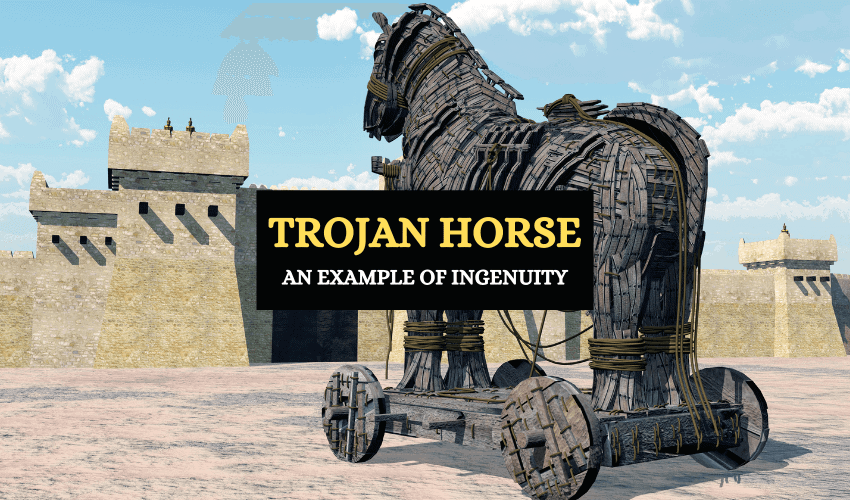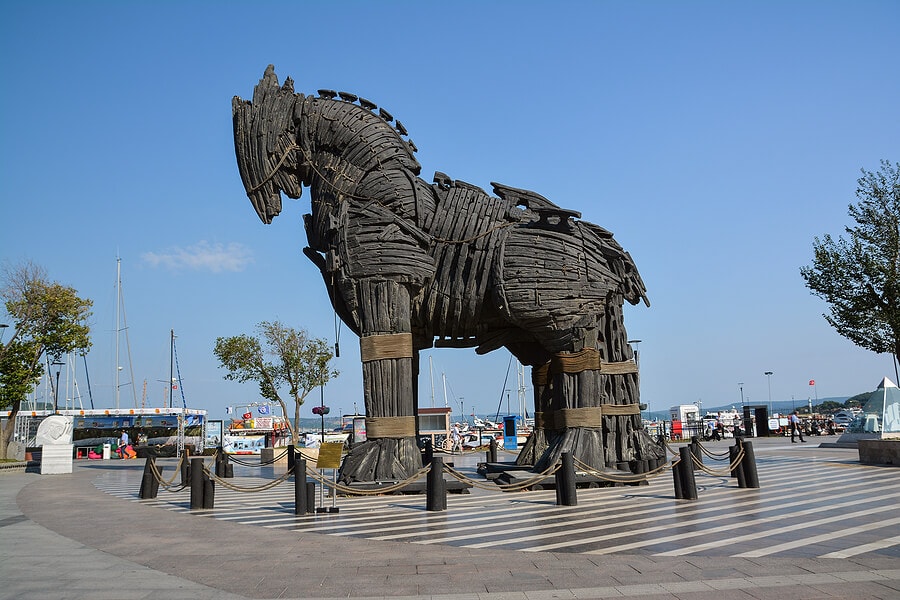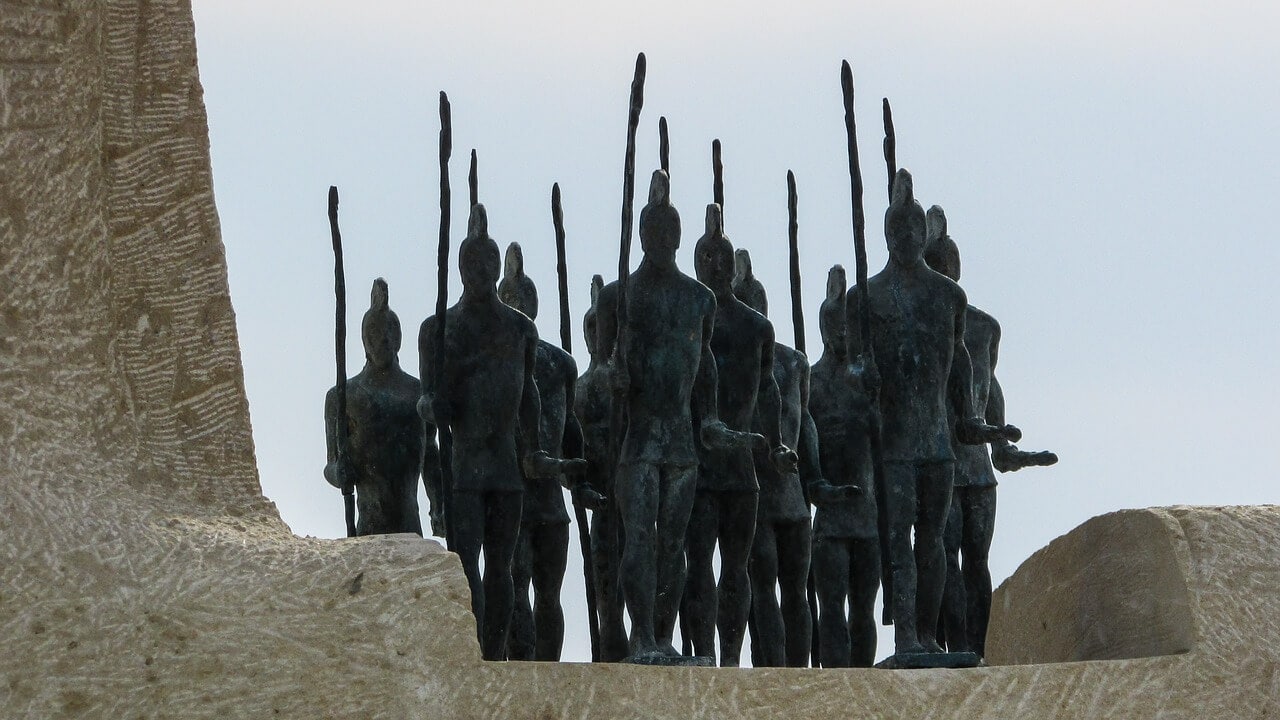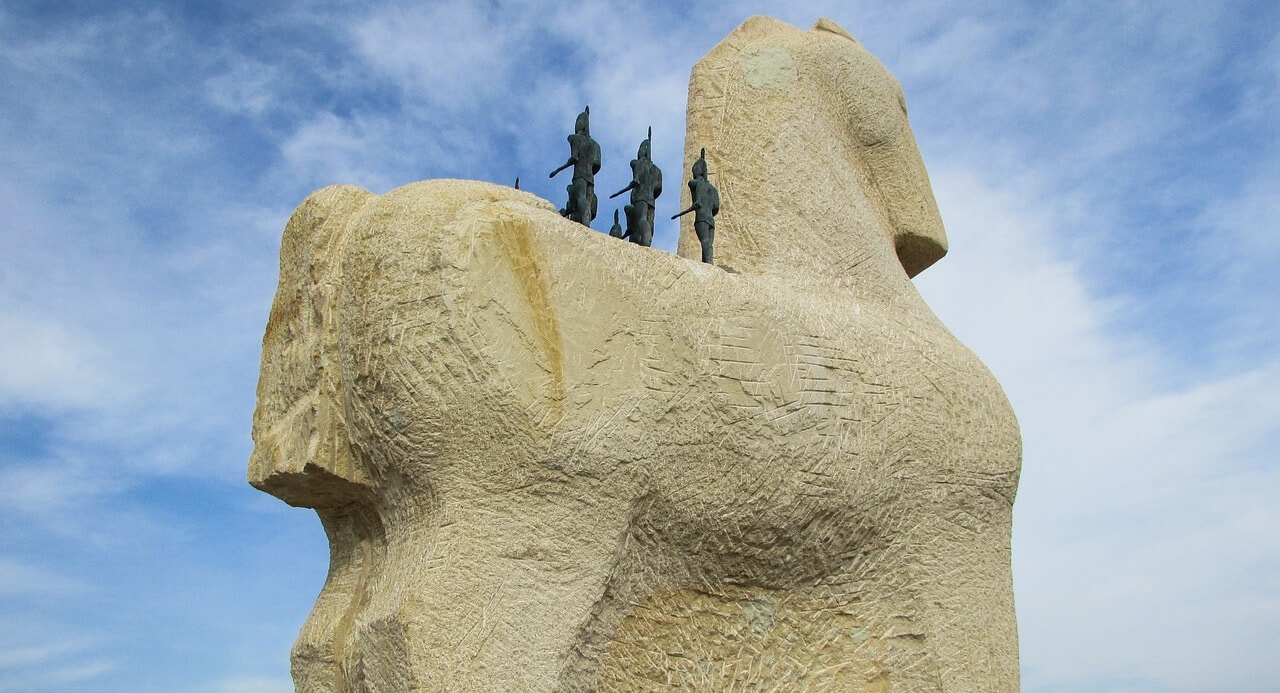
Table of Contents
The Trojan Horse was a large, hollow wooden horse built by the Greeks, which played a crucial role in the ending of the Trojan War. It marked the turning point of the war which had continued for ten years, and brought about the destruction of the city of Troy.
The Start of the Trojan War
The Trojan War began with the elopement of Helen, the wife of King Menelaus of Sparta, and Paris, the Prince of Troy. This was the spark that ignited the war. Menelaus joined forces with his brother, Agamemnon and together, they waged war against Troy.
Two of the greatest warriors in history fought in the war, Achilles on the side of the Greeks, and Hector on the side of the Trojans. Even though both heroes were killed, the war still continued to rage on.
Many prophecies were made by Helenus and Calchus about how Troy would one day fall, but even with the help of Heracles, Troy held firm. The Trojans possessed an archaic wooden statue of Athena, the goddess of wisdom and battle strategy, which they preserved in their citadel.
It was said that as long as the statue (known as the Palladium) was within the city, Troy couldn’t be conquered. The Achaeans managed to steal the Palladium from the city but even so, the city stood strong.
The Trojan Horse

After ten long years of fighting, the Achaean heroes were weary and it looked as though there was no hope of conquering Troy. However, Odysseus, who was guided by Athena decided that the time was right for subterfuge and put forth the idea of the Trojan Horse.
A large, wooden horse was to be constructed with a hollow belly that could hold several heroes in it. Once the horse was completed, the Trojans would have to be enticed into taking it into their city, as the horse was the symbol of the City of Troy.
In order to make the plan work, the Achaeans needed a master-engineer, who they found in the form of Epeius. While Epieus had a reputation of being cowardly, he was an excellent architect and very skilled in his field. It took him all of three days to build the Trojan Horse on wheels, using fir planks, with only a few helpers.
On one side of the horse, he added a trap-door for the heroes to get in and out of the horse, and on the other side he engraved the words ‘For their return home, the Greeks dedicate this offering to Athena’ in large letters, which was to fool the Trojans into thinking that the Greeks had given up the war effort and returned to their lands.
Upon completion, the Trojan Horse was a masterpiece with bronze hooves and a bridle made of bronze and ivory. Although the Trojans saw the Greeks building the Horse, they didn’t see the compartment inside its belly or the ladder that was inside it. They also didn’t happen to see holes inside the horse’s mouth which were created to let air into the compartment.
The Heroes in the Trojan Horse

Once the Trojan Horse was ready, Odysseus began to persuade all of the bravest and highly skilled warriors to climb into the belly of the horse. Some sources state that there were 23 warriors hidden inside it, while others say the number was somewhere between 30 and 50. The most famous of these warriors included the following:
- Odysseus – Known as the most cunning of all the Greek heroes.
- Ajax the Lesser – The King of Locris, well-known for his speed, strength and skill.
- Calchas – He was the Achaean seer. Agamemnon often went to Calchas for counsel and he relied heavily on what the seer said.
- Menelaus – The Spartan king and husband of Helen.
- Diomedes – The King of Argos and the greatest Achaean hero after the death of Achilles. He also injured the gods Aphrodite and Ares during battle.
- Neoptolemus – One of Achilles’ sons, who was meant to fight at Troy for the Achaeans to gain victory, according to a prophecy.
- Teucer – Son of Telamon and another highly skilled and noted Achaean archer.
- Idomeneus – A Cretan king and hero, who killed up to 20 of the Trojan heroes.
- Philoctetes – The son of Poeas, who was highly skilled in archery, and one who arrived late to the fighting. It’s said that he was also the owner of Hercules’ bow and arrows.
Discovering the Wooden Horse
The Greek heroes hid inside the Trojan Horse and the rest of their army burned their tents and boarded their ships, setting sail. Their intention was for the Trojans to see them and believe that they had abandoned the war. However, they didn’t sail too far. In fact, they docked their ships nearby and waited for the signal to return.
Early the next morning, the Trojans were surprised to see that their enemies had left, leaving behind the Wooden Horse, and a Greek hero known as Sinon, who claimed that the Greeks had ‘abandoned’ him.
Sinon and the Trojans
Leaving Sinon behind was part of the Achaeans’ plan. It was Sinon’s duty to give them the signal to attack by lighting a beacon, and to convince the Trojans to take the Wooden Horse into their city. When the Trojans captured Sinon, he told them that he’d had to flee the Achaean camp because they were about to sacrifice him, so that they would have favorable winds to return home.
He also informed them that the Trojan Horse had been left behind as an offering to the goddess Athena and that it had been built so large on purpose to make sure that the Trojans wouldn’t be able to take it into their city and gain Athena’s blessings.
Most of the Trojans believed the story because Sinon looked harmless, but some were doubtful about the Wooden Horse. Among them was a priest of Apollo called Laocoon who, according to the Aeneid (11, 49), stated “Timeo Danaos et dona ferentes” meaning Beware of Greeks bearing gifts.
Laocoon was almost about to discover the Achaeans hiding inside the Horse when Poseidon, the god of the sea, sent two sea serpents to strangle Leocoon and his sons.
According to Homer, Helen of Troy was also doubtful about the Wooden Horse. She walked around it and guessing that there might be Greeks hiding inside, imitated the voices of their wives, hoping that they would expose themselves. The Greeks were tempted to jump out of the Horse but luckily for them, Odysseus restrained them.
Cassandra’s Prophecy
Cassandra, the daughter of the Trojan King Priam had the gift of prophecy and she insisted that the Trojan Horse would cause the downfall of their city and the royal family. However, the Trojans chose to ignore her and instead they played into the hands of the Greeks and wheeled the Horse into the city.
The Trojans consecrated the Wooden Horse to the goddess Athena and began to celebrate their victory, completely unaware of the danger that was to befall them.
The Greeks Attack Troy

At midnight, Sinon opened the gates of Troy and lit a beacon according to plan. Agamemnon, who was waiting for this signal, returned with his Achaean fleet to the shore and about an hour later, Odysseus and Epeius unlocked the trapdoor.
Echion, one of the heroes, was too excited to get out of the horse that he fell down and snapped his neck, while the others used the rope-ladder that was hidden inside. All too soon, Agamemnon’s army began to storm in through the gates of Troy and in no time at all they had taken over the city. The Trojan Horse had helped the Greeks to achieve in one night what they couldn’t in ten years of war.
The Trojan Horse Today
It’s important to note that the Greeks didn’t win the Trojan War by might, but by wit and cunning. By appealing to the Trojans’ pride and by using trickery and deceit, they were able to decisively end the war.
Today, the Trojan Horse is a term that has come to mean any strategy or trick that can cause the target to invite their enemy in and to breach security.
In the latter part of the 20th century, the term Trojan Horse was used as a name for computer codes that imitated legitimate applications but were written to disrupt or cause damage to computers and steal personal information. Simply put, a Trojan Horse is a type of malicious computer virus that can take control of your computer while pretending to appear harmless.
In Brief
The Trojan Horse was a clever idea that turned the tide of the war in favor of the Greeks. It effectively ended the war, demonstrating the ingenuity of the Greeks. Today the term Trojan Horse is a metaphor for a person or a thing that appears harmless on the surface, but is in fact, workign to undermine the enemy.








